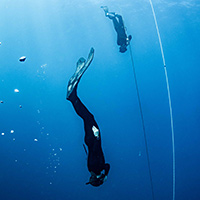Since the New Year I have been busy with many aspects of the project, such as designing a logo…

…and processing the large quantity of photo-IDs from the 2016 season. Photo-identification, a powerful tool to measure population size and structure, basically means taking a picture of the same area each time we encounter a shark. Because we taking photographs of the same side and part of the animal, the left side of the flank, comparing different individuals is much easier as all whale sharks bear unique spot patterns, just like human fingerprints (see below for examples).
While I like to remember by heart the patterns of individuals we often see, the website whaleshark.org, a Wild Me project that allows anyone (including you!) who has photo-identified a whale shark to upload their pictures, is of tremendous help. The Groth algorithm, originally designed to help map stars imaged by NASA’s Hubble Space Telescope, was adapted to match spot patterns and can be applied to track any animal with unique spot patterns, which do not change as the animal ages. A wonderful coincidence as the Malagasy word for whale sharks, “marokintana”, means “many stars”.
Once a photo-ID has been uploaded onto the website following an encounter with a whale shark, the spot pattern is compared with a database of 56,000 photographs taken by researchers, divers and citizen scientists, and given a match score with sharks that share a similar spot pattern. The highest score usually points to the same shark that has been photographed on another occasion, but eventually it remains the scientist final decision to accept whether it is a ‘match’ or not.
That way, a large male that was seen once this year in December, was matched to MD-008, a whale shark that was first seen in 2012 thanks to a photo-ID captured by our local partner Les Baleines Rand’eau during their first year in the whale watching business. While most matches are obvious and easily agreed upon, as the scientist responsable for whale sharks in Madagascar I have to accept or disagree with the matches proposed by the website. Thankfully, sometimes it comes up with the right suggestions which I would never be able to match manually, and brings happy hurray moments.
So, results! We conducted 81 boat-based surveys during September, October, November and December 2016. We recorded 179 separate encounters with whale sharks (meaning the number of times we ‘met’ a whale shark) and identified 85 different whale sharks during the field season, with 3 additional sharks spotted in August by Baleines Rand’eau outside of the season. Most sharks are males (77.6%) with a smaller proportion of females. Sharks ranged from 3.5m to 8 m in length, indicating a juvenile population. The total number of whale sharks identified through both 2015 and 2016 is difficult to establish due to the bad quality of some of last year’s pictures when no scientist was present, but we estimate it to range between 130-150 individuals.

While the majority of the sharks were only seen once in 2016, about half were sighted more than once with 29 sharks previously seen at least another time in 2016. 17 sharks of 2016 were seen already in 2015 and one shark was seen even earlier in 2012! All very exciting.
Amongst our most sighted sharks, the shark we saw the most, a whooping 16 times, is the famous Michel, a rather shy small male with a cut tail. He was already seen in 2015 but only once. We also saw Flore, a small female, 8 times, quite often together with Michel, and then other regular sharks we kept seeing such asMD-039 ‘Raymond’ and MD-153 ‘Bubbles’. Unique scars also allow us to easily recognise individuals, for example Raymond has a large wound and bump across its head while Bubbles bears bubble-like small scars (of course) on his head and flanks. You can easily see the difference between spot patterns in these pictures below.




Finally, 8 satellite tags (SPOT-5) were deployed during the season, with 6 males and two females tagged, who transmitted their location to the ARGOS satellite system each time they surfaced. The tags show that the whale sharks stay in North-West Madagascar but not in Nosy Be necessarily during the season, and leave at the end of December, which coincides with field observations.

These new results are shedding light on the previously unknown population size and structure of the whale shark aggregation in Nosy Be, and so far exceeded all our expectations regarding the number of individuals! We are busy preparing the upcoming season and soon will be recruiting assistants, so stay posted!
A big thank you to ou research assistants Fadia and Jens, as well as to Juliet, Julien, Patrick, Arthur and Tanguy for collecting photo-IDs!

 March 06, 2017
March 06, 2017